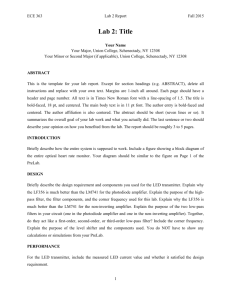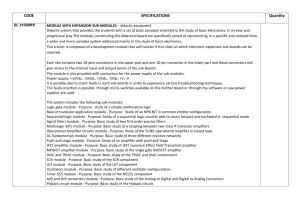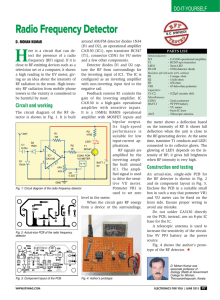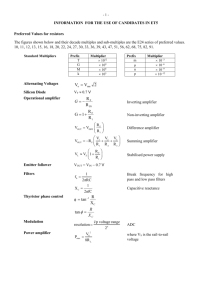Electromagnetic Field Detector
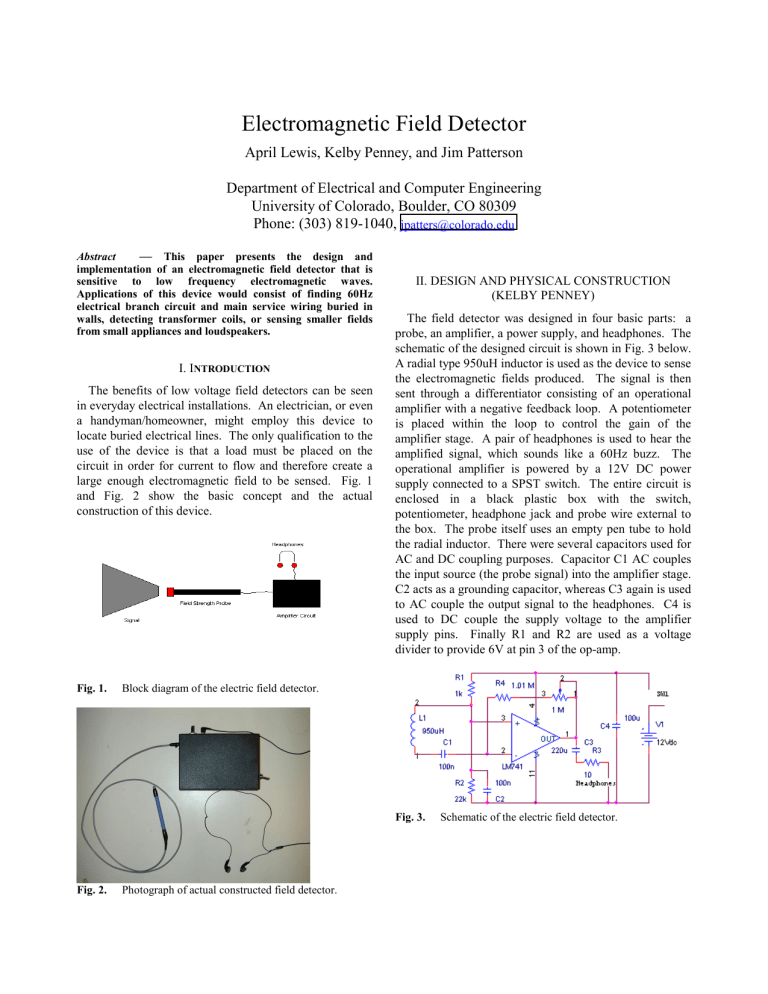
Electromagnetic Field Detector
April Lewis, Kelby Penney, and Jim Patterson
Department of Electrical and Computer Engineering
University of Colorado, Boulder, CO 80309
Phone: (303) 819-1040,
jpatters@colorado.edu
Abstract — This paper presents the design and implementation of an electromagnetic field detector that is sensitive to low frequency electromagnetic waves.
Applications of this device would consist of finding 60Hz electrical branch circuit and main service wiring buried in walls, detecting transformer coils, or sensing smaller fields from small appliances and loudspeakers.
II. DESIGN AND PHYSICAL CONSTRUCTION
(KELBY PENNEY)
I. I NTRODUCTION
The benefits of low voltage field detectors can be seen in everyday electrical installations. An electrician, or even a handyman/homeowner, might employ this device to locate buried electrical lines. The only qualification to the use of the device is that a load must be placed on the circuit in order for current to flow and therefore create a large enough electromagnetic field to be sensed. Fig. 1 and Fig. 2 show the basic concept and the actual construction of this device.
The field detector was designed in four basic parts: a probe, an amplifier, a power supply, and headphones. The schematic of the designed circuit is shown in Fig. 3 below.
A radial type 950uH inductor is used as the device to sense the electromagnetic fields produced. The signal is then sent through a differentiator consisting of an operational amplifier with a negative feedback loop. A potentiometer is placed within the loop to control the gain of the amplifier stage. A pair of headphones is used to hear the amplified signal, which sounds like a 60Hz buzz. The operational amplifier is powered by a 12V DC power supply connected to a SPST switch. The entire circuit is enclosed in a black plastic box with the switch, potentiometer, headphone jack and probe wire external to the box. The probe itself uses an empty pen tube to hold the radial inductor. There were several capacitors used for
AC and DC coupling purposes. Capacitor C1 AC couples the input source (the probe signal) into the amplifier stage.
C2 acts as a grounding capacitor, whereas C3 again is used to AC couple the output signal to the headphones. C4 is used to DC couple the supply voltage to the amplifier supply pins. Finally R1 and R2 are used as a voltage divider to provide 6V at pin 3 of the op-amp.
Fig. 1.
Block diagram of the electric field detector.
Fig. 2.
Photograph of actual constructed field detector.
Fig. 3.
Schematic of the electric field detector.
III. DIFFER. AMPLIFIER W/ VARIABLE GAIN
(APRIL LEWIS)
The amplifier stage of the circuit has an inverting RC differentiator, shown in Fig. 4, that has a negative feedback loop with a variable gain between -76 and -113.
The variation in the gain is obtained by changing the value of the potentiometer. The potentiometer ranges from 0 to
1 M ohms. The large gain is necessary to amplify the signal to an audible range. The capacitor (C1) is used to obtain the required gain as well as AC couple the input signal. The AC coupling blocks any DC current from entering the amplifier stage. Therefore, the headphones will not produce a sound unless the probe detects an AC signal. [3] amplifier. The op-amp circuit has various amplifier types using BJT transistors. These types include several different differential amplifiers as well as a network of current mirrors, common-emitter and common collector amplifiers. This network, along with the feedback loop external to the op-amp, creates the large gain as well as a relatively low output resistance for the differentiator amplifier circuit. [2]
Fig. 4. RC Differentiator w/ gain of (-RC) [3]
The LM741 operational amplifier was chosen for this application for several reasons. The minimum supply voltage of the operational amplifier is 10 V, which is below the 12 V that is used. The bandwidth of the amplifier is also well within the required range of 60 Hz, but most importantly the amplifier is cost efficient. The specifications of the LM741 are in Fig. 5 below.
Fig. 5. Specifications of LM741 op-amp [4]
The operational amplifier itself consists of a network of transistors making up several stages of amplification. Fig.
6 shows the schematic for the LM741 operational
Fig. 6. Schematic for LM741 op-amp[4]
IV. RADIAL CAN TYPE INDUCTOR - PEN PROBE
(JIM PATTERSON)
A radial can-type inductor is used for the probe.
Through Faraday’s Law, emf = -dphi/dt, we know that an induced electric field on the coil will occur due to any B field generated by a current. This will be noticeable if the current is in close enough proximity to the inductor coil and the resultant signal, voltage change, will be amplified and heard in the headphones as a 60Hz buzz. The direction and magnitude of the B field are extremely variable, which creates different induced E fields in the probe at every moment in time and space. The magnetic flux through the inductor is found as phi = integral(B*ds). The surface (ds) through which the B field is integrated is the area inside the inductor coil (pi*r^2). Therefore, the change in this generated flux will create an induced electric field and emf. [1]
V. D ISCUSSION
This paper presents an example of a viable design and implementation of an electromagnetic field detector. The actual experimental results using the detector were much less sensitive than expected. The practical applications of the device would be limited to trivial detection of strong fields in close proximity.
We conclude that a more sensitive field detector could be designed and constructed with a larger budget allowing for a better probe design and a different type of amplifier.
R EFERENCES
[1] Z. Popovic, B. Popovic, Introductory Electromagnetics . pp.
265-277, 2000.
[2] A. Sedra, K. Smith, Microelectronic Circuits . pp.893-921,
2004.
[3] R. Thomas, A. Rosa, The analysis and design of linear circuits , pp.260-265, 2004.
[4] www.national.com
.

